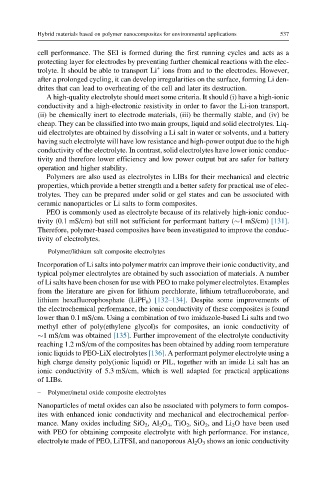Page 584 - Polymer-based Nanocomposites for Energy and Environmental Applications
P. 584
Hybrid materials based on polymer nanocomposites for environmental applications 537
cell performance. The SEI is formed during the first running cycles and acts as a
protecting layer for electrodes by preventing further chemical reactions with the elec-
+
trolyte. It should be able to transport Li ions from and to the electrodes. However,
after a prolonged cycling, it can develop irregularities on the surface, forming Li den-
drites that can lead to overheating of the cell and later its destruction.
A high-quality electrolyte should meet some criteria. It should (i) have a high-ionic
conductivity and a high-electronic resistivity in order to favor the Li-ion transport,
(ii) be chemically inert to electrode materials, (iii) be thermally stable, and (iv) be
cheap. They can be classified into two main groups, liquid and solid electrolytes. Liq-
uid electrolytes are obtained by dissolving a Li salt in water or solvents, and a battery
having such electrolyte will have low resistance and high-power output due to the high
conductivity of the electrolyte. In contrast, solid electrolytes have lower ionic conduc-
tivity and therefore lower efficiency and low power output but are safer for battery
operation and higher stability.
Polymers are also used as electrolytes in LIBs for their mechanical and electric
properties, which provide a better strength and a better safety for practical use of elec-
trolytes. They can be prepared under solid or gel states and can be associated with
ceramic nanoparticles or Li salts to form composites.
PEO is commonly used as electrolyte because of its relatively high-ionic conduc-
tivity (0.1 mS/cm) but still not sufficient for performant battery ( 1 mS/cm) [131].
Therefore, polymer-based composites have been investigated to improve the conduc-
tivity of electrolytes.
– Polymer/lithium salt composite electrolytes
Incorporation of Li salts into polymer matrix can improve their ionic conductivity, and
typical polymer electrolytes are obtained by such association of materials. A number
of Li salts have been chosen for use with PEO to make polymer electrolytes. Examples
from the literature are given for lithium perchlorate, lithium tetrafluoroborate, and
lithium hexafluorophosphate (LiPF 6 ) [132–134]. Despite some improvements of
the electrochemical performance, the ionic conductivity of these composites is found
lower than 0.1 mS/cm. Using a combination of two imidazole-based Li salts and two
methyl ether of poly(ethylene glycol)s for composites, an ionic conductivity of
1 mS/cm was obtained [135]. Further improvement of the electrolyte conductivity
reaching 1.2 mS/cm of the composites has been obtained by adding room temperature
ionic liquids to PEO-LiX electrolytes [136]. A performant polymer electrolyte using a
high charge density poly(ionic liquid) or PIL, together with an imide Li salt has an
ionic conductivity of 5.3 mS/cm, which is well adapted for practical applications
of LIBs.
– Polymer/metal oxide composite electrolytes
Nanoparticles of metal oxides can also be associated with polymers to form compos-
ites with enhanced ionic conductivity and mechanical and electrochemical perfor-
mance. Many oxides including SiO 2 ,Al 2 O 3 , TiO 2 , SiO 2 , and Li 2 O have been used
with PEO for obtaining composite electrolyte with high performance. For instance,
electrolyte made of PEO, LiTFSI, and nanoporous Al 2 O 3 shows an ionic conductivity

